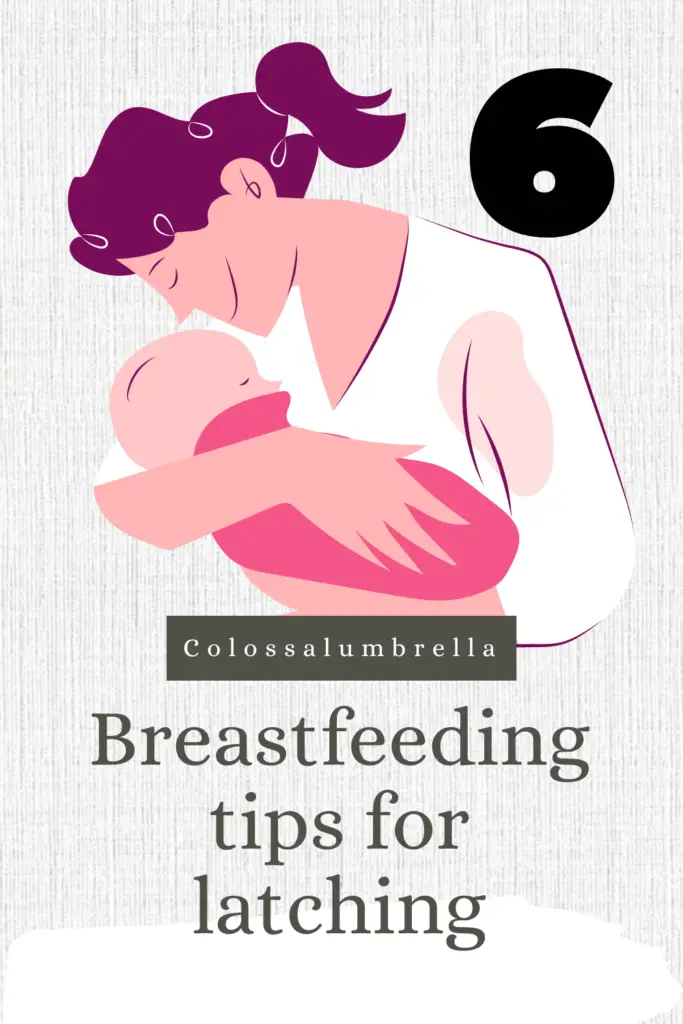Contents
Are you a new mom, anxious and nervous, trying to understand how to breastfeed your little one? Let me tell you, it’s not as easy as it looks in the movies. It is a bit like trying to hit a moving target with your eyes closed while standing on one foot. I know I am exaggerating slightly but the point is it is not easy.
One of the most important things to master when it comes to breastfeeding is latching. You might be wondering, “What the heck is latching?” Well I did. I remember when my baby was handed over to me, I was like what now. In simple language latching is when your baby attaches their mouth to your breast and begins to suck.
This blog post covers simple breastfeeding tips for latching. I’ll cover everything from recognizing the signs of a good latch to dealing with common problems like nipple pain and soreness.
Latching and Its Importance
Before we dive into the tips and tricks, it is important to understand what latching is and why it’s important. Latching is when your baby takes your nipple and areola into their mouth and begins to suckle. A good latch is crucial for successful breastfeeding, as it allows your baby to get the milk they need while also preventing nipple pain and soreness.
A good breastfeeding latch is crucial for several reasons:
- Adequate Milk Transfer: When your baby latches correctly, they can efficiently draw milk from your breast, ensuring they receive enough nutrients for growth and development.
- Prevent Nipple Pain: A poor latch can lead to nipple pain, soreness, and even injury, making breastfeeding an uncomfortable experience for the mother.
- Maintain Milk Supply: Effective milk transfer helps stimulate your breasts to produce more milk, ensuring a consistent supply for your baby.
What Causes Poor Latch
Several factors can contribute to a poor latch during breastfeeding. Below are few of them –
- Incorrect positioning of the baby
- Flat or inverted nipples
- Tongue-tie or other physical issues in the baby
- Lack of knowledge or support
Signs of Good Latching
A good latch will look and feel different for every mother-baby pair, but there are a few things to look out for:
- Your baby’s mouth is wide open, with their lips flanged out like a fish.
- Their chin is pressed into your breast, and their nose is clear and not pressed against your breast.
- You can see more of the areola above your baby’s mouth than below it.
- You can hear your baby swallowing.
Subscribe to my blog for Parenting tips that will make you feel like a pro, and get access to exclusive free Printables that will keep your little ones busy and happy!
Essential Breastfeeding Tips for Latching
Learn the Signs of a Good Latch
To achieve a successful latch, it’s essential to know what a good latch looks and feels like. Here are some key indicators:
- Your baby’s chin is touching your breast, and they can breathe through their nose.
- Their mouth is open wide, and they have a mouthful of your areola (not just your nipple).
- The latch doesn’t hurt or cause discomfort.
- Your baby starts with short sucks before sucking more slowly and deeply.
Breastfeeding tips for latching
Choose the Right Latching Position
There are several latching breastfeeding positions to try, and finding the one that works best for you and your baby is crucial. Some popular positions include:
- Cradle Hold: Hold your baby across your lap, with their head resting on your forearm and their body facing you. Support your breast with your other hand, and bring your baby to your breast.
- Football Hold: Position your baby under your arm, with their legs extended behind you. Support their head with your hand, and bring them to your breast.
- Side-Lying Position: Lie down on your side, with your baby facing you. Use your lower arm to support your head, and your other hand to support your breast.
Encourage Your Baby to Open Wide
Before your baby latches, encourage them to open their mouth wide by gently touching your nipple against their upper lip. The wider their mouth, the easier it will be to achieve a good latch.
Bring Your Baby to Your Breast
Once your baby has opened their mouth wide and brought their tongue over their bottom gum, bring them onto your breast, aiming your nipple towards the top of their mouth. Their chin should touch your breast first, taking in a large portion of your areola.
Keep Your Baby Close
Keep your baby close to you during breastfeeding, with their chin in contact with your breast. This helps ensure a deep latch and makes it easier for your baby to breathe while feeding.
Monitor Your Baby’s Feeding
Watch your baby during breastfeeding to ensure they’re feeding effectively. Look for signs like jaw movement, sucking, and swallowing, as well as short, rapid sucks followed by slower, deeper sucks once your milk starts flowing.

Common Problems with Latching
While latching can be a challenge, there are several common problems that you may encounter and solutions to help overcome them:
Nipple pain and soreness: This is one of the most common problems with latching. To prevent pain and soreness, make sure your baby is latching properly and adjust your position if needed. If you’re experiencing pain, try expressing a little milk before nursing or using a lanolin cream to soothe sore nipples.
Engorgement: This occurs when your breasts become overfilled with milk, making it difficult for your baby to latch. To relieve engorgement, try applying a warm compress or taking a warm shower before nursing. You can also try using a breast pump to express some milk before nursing.
Blocked milk ducts: This happens when a milk duct becomes clogged, causing pain and discomfort. To prevent blocked ducts, make sure your baby is latching properly and alternate between breasts at each feeding. If you do experience a blocked duct, try applying a warm compress and gently massaging the affected area.
Mastitis: This is an infection of the breast tissue that can cause fever, chills, and flu-like symptoms. To prevent mastitis, make sure you’re getting enough rest, staying hydrated, and nursing frequently. If you do develop mastitis, seek medical treatment right away.
Maintaining a Healthy Lifestyle and Diet
While focusing on breastfeeding tips for latching, it’s essential not to overlook the importance of a healthy lifestyle and diet for both mother and baby. Ensure you’re consuming a diet rich in nutrients, staying hydrated, and getting enough rest. Avoid smoking and limit alcohol consumption, as these can impact your milk supply and your baby’s health.
Conclusion
Breastfeeding is like a rollercoaster ride – it’s full of twists, turns, and unexpected drops. But don’t worry, you’ve got this!
Latching can be a bit of a challenge, but with the right knowledge and support, you and your baby can conquer it like a boss. Think of it like a game of “Operation” – you just need to find the right spot and gently guide your little one to it.
Now, I’m not gonna lie – there may be some moments where you feel like throwing in the towel and running to the nearest coffee shop for a latte. But remember, the rewards of breastfeeding are so worth it. Not only does it provide your baby with essential nutrients and antibodies, but it’s also a beautiful bonding experience for the both of you.
So, don’t be afraid to seek out professional support if you need it. There’s no shame in asking for help, and trust me, those lactation consultants have seen it all (and I mean ALL).
Breastfeeding tips for latching
I would stay connected and keep you updated with parenting tips, pregnancy guides, creative ideas, easy crafts, and Free Printables. Subscribe to Colossalumbrella to get new ideas delivered to your inbox. Follow me on Facebook, Pinterest, Twitter, and Instagram.
